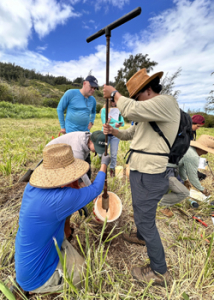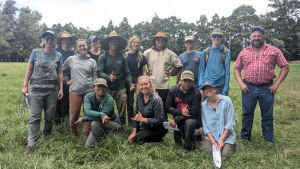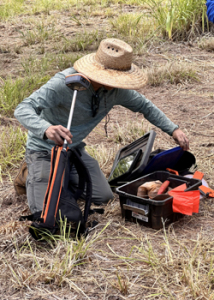
University of Hawaiʻi at Mānoa researchers are preparing for the next phase of a U.S. Department of Agriculture (USDA) grant of up to $40 million to assist Hawaiʻi farmers, ranchers and foresters implement sustainable, climate-smart practices.
The research team out of the UH Mānoa College of Tropical Agriculture and Human Resources (CTAHR) is leading a diverse coalition of partners that is also aiming to establish stronger markets for locally produced, healthy food and forest products. The principal investigator, CTAHR Professor Susan Crow, participated in a question and answer session with UH News to provide a project update.

What has happened since the award was announced in 2022?
We have [enrolled] nearly 6,000 acres of agricultural land in the project across Hawaiʻi Island, Kauaʻi, Maui, Oʻahu, and Molokaʻi with more than 50 producers and practitioners in our first phase, with a second recruitment phase coming up. We wanted a portfolio that reflected the diversity of our producers across forestry, ranching, and crops, as those systems define Hawaiʻi’s agricultural sector and agroecosystems. Beyond ranching, forests, the crops include coffee, ʻulu (breadfruit), avocado, nuts and fruit orchards, diverse crops including greens, herbs, beans, kalo, squash, cabbage, papaya, bananas, you name it!
We have been able to recruit and retain UH Mānoa graduates and staff to support the research efforts that include soil analyses from all enrolled farms and development of data-driven decision making tools grounded in equity and justice. Our Climate Smart Specialist team has logged 880 hours of direct producer support time and taken 401 deep soil carbon samples.
Can you expand on the soil sampling and its importance to the project’s first phase?

After nearly 20 years of research, and 19 extramural projects totaling $13.9 million, the Hawaiʻi Soil Health Research Team released the Hawaiʻi Soil Health test and scoring function in 2023. The Hawaiʻi Soil Health test and the robust research program behind it serves as the basis for understanding what climate-smart means for Hawaiʻi.
The initial samples, or baseline samples as we call them, taken for the climate-smart partnership enable us to understand how implementation of climate-smart practices such as mulching, soil carbon amendments like biochar and compost, and cover cropping supports not only soil health but also soil carbon storage, and greenhouse gas emissions reduction.
Then, we monitor change over time as the practices are implemented and maintained.
What are the next steps?
The project is going beyond soil health, carbon sequestration, and greenhouse gas emissions reduction to support quantifying climate-smart for Hawaiʻi to encompass social justice and equity. With our project partners in the UH Office of Indigenous Knowledge and Innovation and the Hawaiʻi Natural Energy Institute (a UH Mānoa entity), we are ensuring that we quantify elements such as functional nutrition, circular economy, community wellbeing, and Indigenous genealogy.
This fall we will be opening the applications for phase 2 enrollment for producers and look to enroll 50 additional producers in our project.
As you move forward, what are you the most excited about?

Our partnership’s shared vision is to re-perpetuate health, resilience, and equity in Hawaiʻi’s agroecosystems and communities. This project provides us the opportunity to define “what is climate-smart” in a way that embodies place-based equity, and here in Hawaiʻi, indigeneity is part of that.
We support science-backed decision making, and by science, we acknowledge multiple ways of knowing, and the rigor comes from a definition of climate-smart that is inclusive of Indigenous innovation—otherwise, how can this work for Hawaiʻi as a more just and equitable metric for what is “climate-smart?”
We are charged with laying the foundation for an emergent market for “climate-smart” products, think, “grown in Hawaiʻi, for Hawaiʻi.” Ultimately this will provide our producers and practitioners a strong, local market for items grown in a sustainable way; but also provide more resilience in our food system and ability to provide food security for local families in a way that sustains people and the environment.
How important is it to be an ambassador for the project and the university?
Representing the university in a partnership that focuses on climate change, agriculture, food systems, and social justice allows us to build the trust essential for the future mitigation and adaptation to climate change in Hawaiʻi. UH has always been a leader in serving the communities of Hawaiʻi with excellence and relevance, and this project is an exciting example of the service ethic. With such a broad reaching project with network partners we have the ability to meet the needs of agricultural producers first and foremost, but also local communities, state policy makers, and food systems initiatives while answering fundamental questions about how to approach incentivizing climate adaptation and mitigation efforts.

